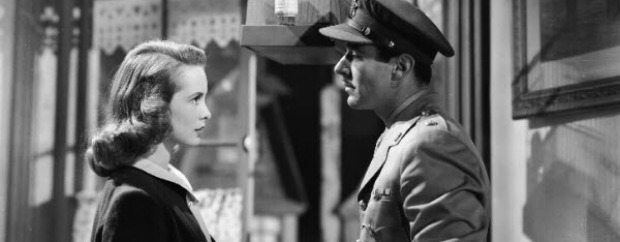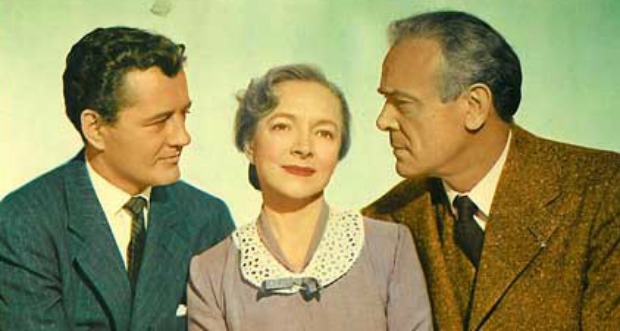
The moon is red: the legacy of Cold War Hollywood

On 5 March 1946, at a small college in Fulton, Missouri, Sir Winston Churchill used a phrase that immediately entered the international lexicon when he declared that “an iron curtain has descended across the continent,” specifically central and eastern Europe. That was all Hollywood had to hear. The end of World War II required new villains. The Nazis and Japanese would never go out of vogue, but they would no longer be the grotesques that they were in the 1940s. Then, Nazis ranged from sadistic (None Shall Escape) to stupid (Desperate Journey). The Japanese were not even worthy of a range. They were Yellow Peril stereotypes who inserted bamboo shoots under fingernails (Behind the Rising Sun), gouged out eyes and pulled out tongues (Manila Calling), and gang raped Chinese women (Dragon Seed, China).
A year after the Iron Curtain speech, The House Committee on Un-American Activities (HUAC) launched an investigation into the so-called Communist subversion of the movie industry, convinced that left-wing screenwriters were inserting Communist propaganda (such as “Share and share alike” in Tender Comrade, 1943) into their scripts. Next, Twentieth Century Fox confirmed Churchill’s dire pronouncement with The Iron Curtain (1948, in which cryptographer Igor Gouzenko, stationed at the Soviet Embassy in Ottawa, defected with enough documentation to expose an atomic spy ring. Not that it mattered, since in 1949, the Soviets proved they could make an atomic bomb. Then came the Red Trio: The Red Menace (1949), Red Planet Mars (1952), and the most prestigious of all, MGM’s The Red Danube (1949), in which a ballerina (Janet Leigh) leaps from a window to her death rather than be repatriated to the Soviet Union. Unsuspecting women married Communists (I Married a Communist, 1949, retitled The Woman on Pier 13), and federal agents posed as them (I Was a Communist for the FBI, 1952). Even a stylized genre like film noir could take on a shade of red (Kiss Me Deadly, 1955). An air of the surreal hung over Cold War movies. They were so shameless in their scorn for verisimilitude they drew audiences into a phantasmagoria, in which Communists were capable of germ warfare (The Whip Hand, 1951) launching a nuclear attack (Invasion USA, 1952 ) or honeycombing Honolulu (Big Jim McLain, 1952), as if Pearl Harbour weren’t enough. And if Elizabeth Taylor could fall for a Communist (Conspirator, 1949), what hope was there for the average American?
But the most fervent anti-Communist movie was Paramount’s My Son John (1952), in which the title character was an intellectual with a Catholic upbringing, suggesting that it was possible to educate oneself out of the Church and into the Party.
The Cold War with its concomitants, HUAC and the blacklist, is such a part of America’s dark side that periodically filmmakers revisit the era and try to make sense of a specter that turned out to be a bogeyman, causing premature deaths and derailing careers, in some cases irrevocably
On February 19, 1951, the New York Times reported that Helen Hayes would be returning to the screen in My Son John, directed by Leo McCarey from his own original screen story, “Leo has sworn us all to secrecy,” Hayes told a reporter However, word had leaked out that the movie was about a mother who killed her son after discovering he was a Communist. “Better dead than Red,” to quote the mantra of the Cold War. My Son John did not result in anything so sensational; if it did, it might have been more interesting. The reason was not the Production Code; 1951 was open season on Communists, now the equivalent of Nazis, if not worse. In The Hour before the Dawn (1944), Franchot Tone killed his wife (Veronica Lake), when he learned she was a Nazi agent; if a husband can kill his Nazi wife, a mother can kill her Communist son. But McCarey chose a different route. The son would be killed, but not by his mother.
Making a movie about Communism became an obsession with McCarey – an obsession that was magnificent only in terms of its magnitude; an obsession that, as it grew, diminished his art.
McCarey was so eager to sign Helen Hayes, a fellow Catholic, for the mother that he traveled to her home in Nyack, New York, where he read her the script, playing all the parts, as Louis B. Mayer once did to persuade Greer Garson to do Mrs. Miniver. While McCarey implied that his virtuoso reading was the deciding factor, Hayes had reasons of her own. After the sudden death of her daughter, Mary MacArthur, in September 1949, Hayes sought refuge in work. She immediately went into Joshua Logan’s production of The Wisteria Trees, his transplanting of Chekhov’s The Cherry Orchard to the Deep South, winning good reviews for herself in a play that one critic dubbed “Southern fried Chekhov.” When it closed after five months, the void left by Mary’s death was still there. My Son John helped close it, as did Mrs. McThing, which opened on Broadway at the same time that My Son John went into release.
Because she was still grieving for her daughter (and would for many years), Hayes did not scrutinize the script, which kept getting changed. McCarey admitted as much; on March 30, a month after shooting began, he told the Los Angeles Daily News: “The script isn’t yet finished because it became bigger than I thought. We’re developing it as we go along.”
Since McCarey wanted the script to reflect, at least indirectly, the most recent espionage cases, he had to work without a completed screenplay. He conceived the idea for My Son John in 1950—the year Alger Hiss was convicted of perjury; the year Klaus Fuchs admitted he was a Soviet spy; the year Julius Rosenberg was arrested; the year Judith Coplan’s conviction was overturned because of illegal wiretapping.
While the inspiration for John was clearly Alger Hiss (a brilliant mind seduced by Communism), the constant tampering of the script came from McCarey’s interest in another case: the Rosenbergs. Filming began in early March 1951; the Rosenbergs were sentenced on April 5 and were to have been executed sometime during the week of May 21, although that did not happen for two more years. Still, the Rosenbergs were making headlines in spring 1951. McCarey envisioned a family that was the antithesis of the Rosenbergs: the Jeffersons—Lucille (Hayes) and Dan (Dean Jagger), and their three sons, Chuck (Richard Jaeckel), Ben (James Young), and John (Robert Walker). All were devout Catholics, except for John, who had turned atheist.

The film opened to reviews that were not exactly negative (who could criticize Helen Hayes?) but far from glowing. Hayes didn’t even get an Oscar nomination; McCarey did, not for direction but original screen story. Nor was the film, which ended up costing $1.8 million, a financial success. But few Red Scare movies were. I Married a Communist increased RKO’s 1952 net losses by $650,000. But what is saddest about My Son John was the way three actors—Hayes, Walker, and Jagger were manipulated by a director, who also manipulated the script.
Hayes is forced to act cute; she is first seen on the upstairs porch in her slip, interrupted while dressing for Sunday Mass. She also has to do an imitation of a geisha that today would raise eyebrows of the politically correct. But the unkindest cut of all is having to play a woman who seems to have read only two books: the Bible and the Fannie Farmer Cookbook. She resorts to football imagery to persuade John to break with the Party, urging him to “get into the game” and turning cheerleader as she chants, “My son John, My son John.” She reminds him of the time she tried to get him to read the Scriptures: “I’ll make you cookies, pies, cakes and jam if you’ll learn Matthew, Mark, Luke, and John.”
But John’s bible is Das Kapital. He mocks the parish priest and even his own mother, when she reminisces about the childhood song she sang to him. “Tweedle, deedle, dumpling, my son John.” John responds perversely, “Do it again, mother.” There is no hope for John—that is, until McCarey came up with an ending.
Dean Jagger, an Oscar winner for Twelve O’Clock High (1949), found his role exasperating. As John’s father, an American Legionnaire and grade school teacher, he tries to instill some patriotism in his son by singing in a voice that grows increasingly hoarse: “If you don’t like your Uncle Sammy/Go back to your home o’er the sea.” Since John obviously does not like his Uncle Sammy, his father despairs of winning his son over to the American way, which John dismisses as “good old American bromides.”
The real victim of My Son John was Robert Walker, whose sudden death from a heart attack in August 1951 prevented McCarey from ending the film as he planned. My Son John was to have ended with John’s repudiating Communism in a commencement address, after which he’s gunned down by Party members. Yet McCarey seems to have been dissatisfied with that ending. He decided it would be more dramatic, if John, sensing his days were numbered, recanted (“I am a native American Communist spy, and may God have mercy on my soul”), recorded his address and was then killed.
The commencement, with the recording machine spotlighted and John’s voice seeming to emanate from eternity, is pure theatre. Whether or not McCarey wanted a voice from the grave, he got one. Walker’s death, however, posed other problems.
McCarey resorted to footage from Walker’s last film, Hitchcock’s Strangers on a Train (1951) and used a double in a few scenes, notably of John in a taxi and his getting a telegram about receiving an honorary degree at the commencement. There is also an eerily effective scene in a phone booth in which only John’s disembodied voice is heard on the other end. Nothing as mundane as death would prevent McCarey from coming up with a finished product.
Hayes and Jagger emerged with their reputations intact. Hayes returned to the theatre, and eventually to film, winning an Oscar for Airport (1970). Jagger continued to make movies and landed the role of the high school principal in the TV series, Mr. Novak (1963-65), at, of all places, Jefferson High School. One hopes Jagger appreciated the irony.
McCarey was less fortunate. The energy he poured into My Son John—the muzzling of the cast, the interviews that ranged from cryptic to defensive—eventually sapped his art. He embraced anti-Communism even before the House on Un-American Activities (HUAC) began its hearings in October 1947. When HUAC visited Los Angeles in May 1947 to conduct a dress rehearsal for the official investigation, McCarey was a friendly witness. He was also a friendly witness in October. McCarey’s career began with Laurel and Hardy shorts and ended with Satan Never Sleeps (1962) with Clifton Webb and William Holden as missionaries in Communist China. A strange arc, perhaps, but one in keeping with the changing times and McCarey’s politics.
The Cold War with its concomitants, HUAC and the blacklist, is such a part of America’s dark side that periodically filmmakers revisit the era and try to make sense of a specter that turned out to be a bogeyman, causing premature deaths and derailing careers, in some cases irrevocably. We have already had The Front (1976), The House on Carroll Street (1988), Guilty by Suspicion (1991), and One of the Hollywood Ten. Perhaps Clint Eastwood, Martin Scorsese, or the excellent Ben Affleck will introduce the Social Network generation to a period that abridged the First Amendment rights they take for granted.







COMMENTS